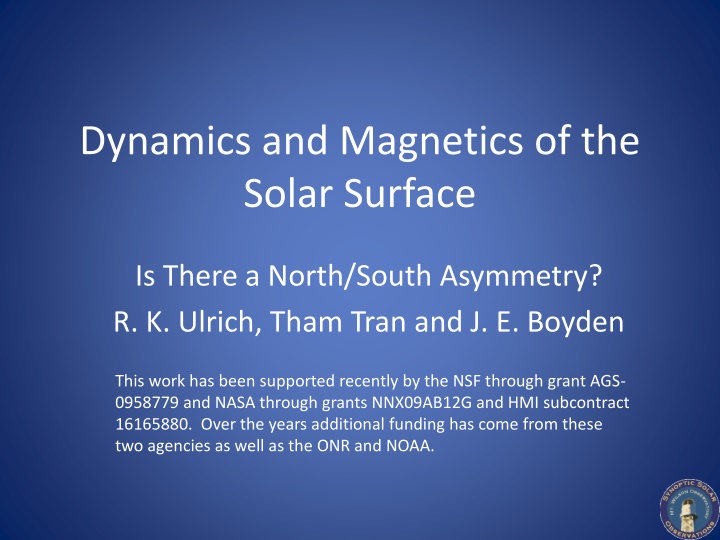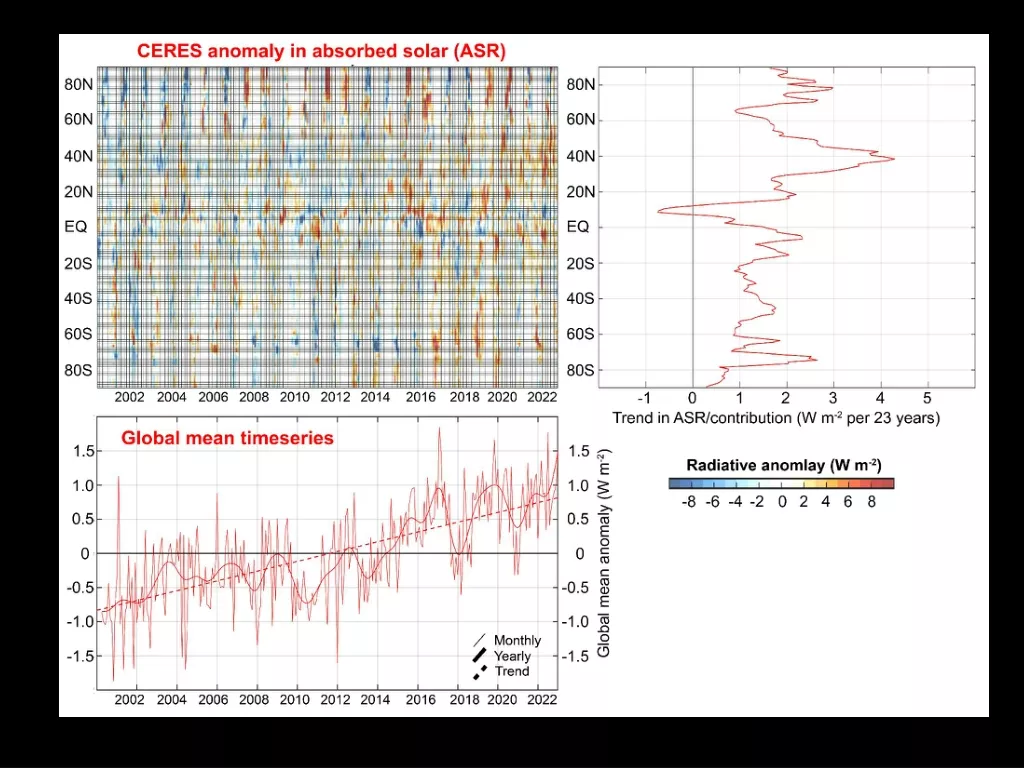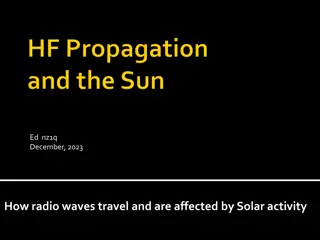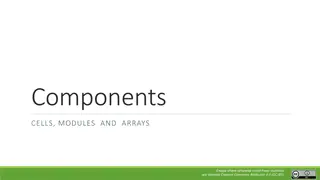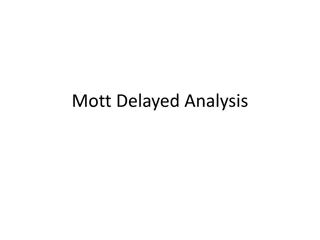Dynamics and Magnetics of the Solar Surface: North/South Asymmetry Study
Research supported by NSF and NASA analyzed solar surface dynamics and magnetics at Mt. Wilson Observatory since 1974. The study compared asymmetries in rotation speed and magnetic fields between the solar hemispheres, providing insights into solar activity cycles and upcoming field reversals. Challenges with Doppler shifts vs. magnetic fields were discussed, along with the project's history and data reduction methods.
Download Presentation

Please find below an Image/Link to download the presentation.
The content on the website is provided AS IS for your information and personal use only. It may not be sold, licensed, or shared on other websites without obtaining consent from the author.If you encounter any issues during the download, it is possible that the publisher has removed the file from their server.
You are allowed to download the files provided on this website for personal or commercial use, subject to the condition that they are used lawfully. All files are the property of their respective owners.
The content on the website is provided AS IS for your information and personal use only. It may not be sold, licensed, or shared on other websites without obtaining consent from the author.
E N D
Presentation Transcript
Dynamics and Magnetics of the Solar Surface Is There a North/South Asymmetry? R. K. Ulrich, Tham Tran and J. E. Boyden This work has been supported recently by the NSF through grant AGS- 0958779 and NASA through grants NNX09AB12G and HMI subcontract 16165880. Over the years additional funding has come from these two agencies as well as the ONR and NOAA.
AGU Fall 2012 Abstract# SH52C-01 The digital records of solar surface magnetic and velocity fields obtained a the 150-foot solar tower telescope at the Mt. Wilson Observatory have been analyzed with a consistent reduction method starting in July 1974. Digital records between 1967 and this date are part of the archive but are not yet reduced with current methods due to their coarser grain of digitization. This 38-year record allows a comparison of the current unusual cycle 24 with three prior cycles. For cycles 22 and 23 the southern hemisphere rotated faster than the northern hemisphere. Both hemispheres have slowed at the beginning of cycle 24 but the asymmetry has not changed substantially. The meridional circulation velocity has not shown such a strong asymmetry. The magnetic fields were stronger in the south for cycles 20 and 22 but not for cycle 23. Both north and south were weak for cycle 23. Polar field reversals in the south have lagged those in the north by intervals between 6 and 18 months. The north field reversal has occurred between June and August of 2012 but appears to be 12 to 24 months away in the south.
What is the question? What are the uncertainties? How do the hemispheres differ and can we learn anything from them? Doppler shifts vs magnetic fields the issues are different. Different parts of the solar image pass through different optical paths. The North and South poles are as far apart as possible and typically pass through different air masses. Problems come from instrumental bias and earth atmosphere differences.
A Brief History of the MWO Project Digital magnetograms and Dopplergrams are available beginning 1967. The current reduction begins in July, 1974. Major instrument changes: 1982 installed fiber-optic image reformattor. 1986 began multiple observations per day (fast- grams). 1991 changed the entrance slit size. 1996 began 24-channel observations.
Velocity Reductions and Rereductions The initial reduction removes: The effect of scattered light. A static differential rotation rate. A variable solid body rotation rate. A static meridional flow rate. A variable limb-shift function based on an equatorial band. Step 1 IDR means Interactive Data Reduction, MVI means magnetic, velocity and intensity.
Data Reductions (cont.) The Doppler images are further corrected by a flat-field derived from pre-1986 data. The old reduction images are 34 by 34 but are not square and do not include any magnetic correction except for a limit. The newer images are converted to 256 by 256 daily average arrays at a fixed time of day. The newer reduction does not apply the older flat field but can require a zero mean at each latitude. The newer reduction does apply a correction to the Doppler images based on magnetic field strength. Step 2A Step 2B
Torsional Oscillations The average flat-field from all observations prior to 1986 has been removed from the observed velocities. This flat field was made North/South symmetric.
Torsional Oscillations, no Flat-field The flat field has altered the differential rotation law but left unchanged the north/south asymmetry.
Conclusion from Steps 1 and 2A The Doppler-shift flat-field removal mostly removes deviations of the rotation rate from the =A+Bcos2(b)+Ccos4(b) fit. We allow A to vary but keep B and C fixed. There may be some scattered light, atmospheric refraction effects we have not yet identified.
The New Reduction Uses daily averages. Applies a correction for the magnetic effects Uses images 256 by 256 pixels Bins result to 2 degree bins in latitude. Starts in 1986
Zonal Velocities, New Reduction This result is without any velocity flat field and is very similar to the result from the old reduction, also without any flat field.
Comments The old and new reductions both show the more rapid rotation of the southern hemisphere. The pattern has been significantly altered by the fact that the =A + Bcos2b + Ccos4b formula does not accurately describe the actual rotation curve.
Torsional Oscillations, new reduction after flat field The north/south asymmetry has now been eliminated by the flat fielding.
The old flat field was based on data prior to 1986.
The North/South asymmetry in the flat fielded new reduction The northern torsional band is faster than the southern band during periods when the torsional pulse is propagating toward the equator.
The Meridional Circulation This figure summarizes the time and latitude dependence of the velocity in the meridional plane. Notice the very low values in 2011. The reversed cell is present for all cycles except for cycle 23. The strength of the circulation was also greater for this cycle.
The north/south asymmetry in the meridional circulation Over most of the period the South meridional circulation has been stronger than that in the North. Since mid-2011, the north has developed a stronger zone in the active region latitudes.
The Magnetic field The southern hemisphere polarity reversal has generally been behind the northern hemisphere reversal. The southern hemisphere reversal has not begun for cycle 24 while the northern hemisphere reversal has begun to migrate toward the pole.
Br versus time for six latitudes. The differences between north and south are less than the differences from one cycle to the next.
Times of polarity reversal These are from spline fits to the Br vs time curves. The zero crossing times are shown. The dashed lines are the official times of solar maximum.
Summary The rotation rate as measured at MWO is greater in the southern hemisphere than in the northern hemisphere by 2 to 4 m/s. The meridional circulation (MC) in the active latitudes is more often stronger in the south than the north. Recently the MC is stronger in the north. The reversed cell at high latitudes is present for all cycles except cycle 23. The strength of MC was very low during the extended minimum between cycles 23 and 24.
Summary (cont.) The high latitude magnetic fields are more alike north and south than they are from one cycle to the next. The most noticeable difference between north and south is the time lag of the south by 6 to 18 months during periods when the polar field reversal occurs. The weakness of the polar fields during cycle 23, the weakness of the meridional circulation and the slowness of the reversal during cycle 24 are striking features of recent solar cycles.
Rotation Derived at Step 1 During the initial step 1 reduction, the velocities are fit to a 4 parameter function, one parameter of which is the solid body rotation A. This parameter is fit with all the data and with four subsets: the north, south, east and west hemispheres. The above plot shows the difference AN AS.
Rotation Derived at Step 1 restricted to times of large b0 This is the same as the previous slide but with the range of b0 restricted to near maxima and minima. These two slides suggest there is something in the initial fit that is influencing the rotation rate. Near-limb, near-pole points are different for the two cases above.
